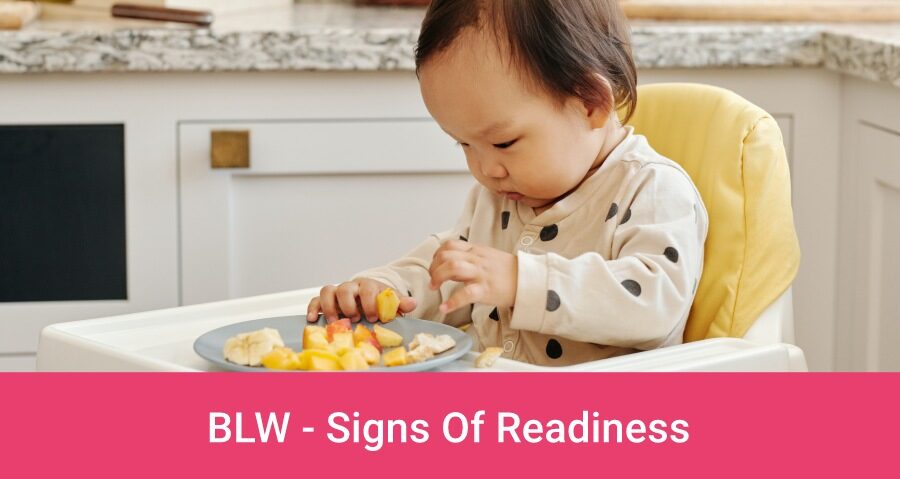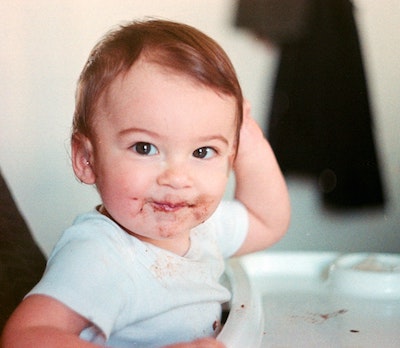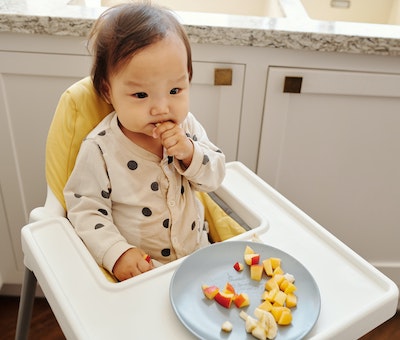Are you wondering if you baby is ready for BLW? In this article I’m discussing the signs of readiness for baby-led weaning that you should look for, before you start offering solid food to your little one.

Article by Jessica Holbrook – Register Nurse & Educator
Baby led weaning is a relatively new strategy to get babies started on solid foods. BLW helps transition your baby from breastfeeding to eating regular meals with the family. Instead of starting solids with pureed food and rice cereals, parents jump right in with foods like broccoli and sliced apples.
Parents who choose baby led weaning do not need to purchase baby food, they simply feed their child the same thing that everyone else is eating, with a few modifications when needed (like spices and bite size).
Starting solids is an important part of your baby’s development. Introducing solids too early creates a higher risk for choking hazards, while starting late might impact baby’s nutrition.
While breast milk is the perfect food for infants, older babies need complementary foods to give them enough calories and nutrition as they grow.
If you start baby led weaning at the right time, it can help your baby reach developmental milestones like oral motor skills and fine motor skills. Baby led weaning is also great for preventing picky eating in the future and helping your child get comfortable with new foods and different food consistency.
| PRO TIP: If you’re thinking about starting BLW with your little one, there are a few things you will need. Invest in a good high chair for BLW – it should be easy to clean (no crumb-catching gaps) and should also feature some adjustments for a growing child. To keep crumbs and spills contained I also recommend you to get one of the best BLW bibs that will make baby-led weaning a bit less messy. |
This article is not a substitute for medical advice.
What Are The Signs Of Readiness For BLW?
Many parents are in a hurry to help their child start self feeding. It is a popular belief that babies start to sleep better after they start solids, and that when a baby can self feed, moms and dads get a little of their own time back.
Around 6 months, you can start looking for developmental signs of baby led weaning readiness. Your baby needs to meet all of these milestones before you try introducing solids. Starting solids too early is dangerous and could lead to choking.
Signs that your baby is developmentally ready for baby led weaning1 include:
Sitting Unsupported In A High Chair
One of the most important developmental signs is your baby’s ability to stay in a sitting position independently.
Good Head And Neck Control
Like sitting unsupported, good head and neck control are readiness signs that will keep your baby safe while trying new foods.
Making Chewing Movements With Their Mouth
For a baby to start eating, they need to learn how to chew. Parents might notice their baby practicing chewing motions while watching others eat.
Trying To Grab Foods
In early childhood, babies seem to grab everything to put it in their mouth. As they get older, they may try to grab food that you are eating or show a lot more interest in what you are doing at the dinner table.
Opening Their Mouth When Solid Foods Are Near
One of the readiness signs for solid food is when your baby opens their mouth as you take a bite of food yourself. As you are feeding yourself, your baby will learn to copy your behavior.

When Should BLW Start?
Baby led weaning should start when your baby reaches at least 6 months of age and is showing signs of readiness.
Just because your baby is 6 months old does not mean they are ready for solids. Make sure that your baby is both developmentally ready and old enough to start eating solid food.
If you have any concerns about your baby swallowing or gagging on foods, follow your pediatricians recommendations about when your baby is ready to start eating solids.
Can You Start BLW At 4 Months?
Babies all progress at different rates. If your baby seems to be hitting developmental milestones early, you may be tempted to start solids or begin the baby led weaning process around 4 or 5 months of age. You may notice that your baby starts eyeing or reaching for your foods and wonder, is my 4 month old ready for food?
Experts from the American Academy of Pediatrics, the World Health Organization, and the American Academy of Family Physicians all recommend that babies consume breast milk as their only food for the first 6 months of life2.
Even if your baby shows signs of readiness, wait until they reach 6 months or older before you introduce solids.
It is common for babies to start reaching for items and putting them in their mouth or sitting up independently before they are 6 months old.
This does not mean they are ready for solid food. Breastfeeding gives your baby all of the nutrients they need up until that age.
My Baby Is 6 Months Old But Cannot Sit Independently – Can I Start BLW?
One of the most important readiness signs3 for baby led weaning is the ability to sit independently. Do not try to give your baby solid foods until they are sitting unsupported and have good control of their head and neck, even if they are over six months of age.
Once your baby can sit independently and control their head well, they are ready to sit in their high chair and experiment with different foods.
Can I Start Purees Before Baby Led Weaning?
There is no perfect way to introduce solids and baby led weaning. Many mothers choose to combine finger foods with purees and have great success. Others feel more comfortable using baby food for a while before experimenting with regular table foods.
Infants can practice eating purees, applesauce, and yogurt with a spoon while still feeding themselves and learning to chew other foods like toast sticks and steamed broccoli.

Signs That Baby Is NOT Ready For Solids
Just like there are signs of readiness for starting solids, there are some signs that your baby is not quite ready to start eating solid foods.
Too Young
Even if you think your baby is ready for solids before six months of age, it is best to follow the recommendations of the American Academy of Pediatrics, and wait until your child is old enough to start eating solids.
For premature babies, you will need to consider their corrected age. Premature babies are at higher risk for choking and lung problems, and may not reach developmental milestones as quickly as full-term babies. If you have a premature infant, you should take your time getting them ready for solids.
Tongue Thrust Reflex
Young infants have a reflex called the tongue thrust reflex. This reflex causes your baby to push food or other objects out of their mouth with their tongue. The reflex helps with breastfeeding, but makes it hard to eat solids. Most babies have a tongue thrust reflex until they are 5 or six months old. Do not attempt solid food until this reflex disappears.
Developmental Delay
If your child has any type of developmental delay, it may be a long time before they start to show developmental readiness for solid foods. Some babies with developmental delays may not be show readiness signs until they are a year or older. Be patient as your baby learns and develops at his or her own pace.
How To Start Baby Led Weaning – Safety Tips
When you are ready for your child to start solid foods, you might feel lost and wonder how to start. One of the best things about baby led weaning is that you can just follow your baby’s lead. You can start by offering your baby many of the same foods as your family normally has at mealtimes.
Finger foods are a good first choice when starting solids. Choosing easy to grab and easy to chew foods like strips of toast are perfect for babies to start feeding themselves. As your baby gets better at their pincer-grasp, you can start offering smaller sized foods.
When feeding your baby, don’t stress too much about the nutrients they are eating. Try to offer a variety of foods, but don’t force them to eat anything they are not interested in. Young babies still get most of their nutrition from breastfeeding or formula. In very early childhood, feeding times should be more about experiencing different textures and flavors.
When starting solids, make sure you keep a constant watch of your baby. Do not turn on the television or play with your phone during mealtimes. If you notice your baby gagging, try not to panic.
Gagging actually means that your baby has the right reflexes they need to protect their airway. It is wise for every adult in your family to learn what to do in an emergency4, whether you use baby led weaning or not.
Make sure you avoid foods that are a choking hazard5. Foods like nuts, uncut grapes, hot dogs, and hard candies are very dangerous for infants and toddlers.
Make sure that you only give your child soft food to start, and watch them closely every time they eat solid food. In addition, babies should not be given food while they are in their car seat or stroller.
Some parents have concerns about allergic reactions when starting solids. Foods like peanut butter, shellfish, milk, and eggs commonly cause allergic reactions in young children. Wait until your child is at least one year old before giving them cow’s milk6.
Many pediatricians argue that early exposure to common allergenic foods reduces the risk of developing allergies. In addition, allergies often run in families, so if you do not have allergies, your child probably won’t either. Talk to your pediatrician if you are worried about a potential allergy.
Medically Reviewed By Jessica Holbrook, RN
Jessica Holbrook has been a registered nurse and educator for over 8 years. She has experience in critical care, neonatal, intensive care, and postpartum intensive care. Currently she’s working in Intermountain Medical Center Coronary Intensive Care Unit. She’s been creating educational materials for both new nurses and patients in the hospital. She has also written for several parenting blogs and healthcare career websites.
The purpose of this article is informative. It’s not a substitute for professional medical advice or medical care. Remember: safety first! Consult your doctor/pediatrician in case of any doubts. The author of this article does not accept any responsibility for any liability, loss or risk, personal or otherwise, incurred as a consequence, directly or indirectly, from any information or advice contained here.
Resources:
https://www.cdc.gov/nutrition/infantandtoddlernutrition/foods-and-drinks/when-to-introduce-solid-foods.html
https://www.healthychildren.org/English/ages-stages/baby/breastfeeding/Pages/Where-We-Stand-Breastfeeding.aspx
https://solidstarts.com/readiness/
https://www.babylist.com/
https://www.cdc.gov/nutrition/InfantandToddlerNutrition/foods-and-drinks/choking-hazards.html
https://health.clevelandclinic.org/baby-led-weaning/

